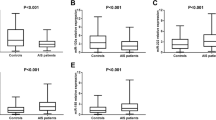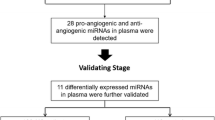Abstract
Ischemic stroke (IS) is a major cause of mortality and disability. However, no reliable prognostic or diagnostic biomarker has been utilized to date. Here, we have evaluated the serum S100B concentration and miR-602 expression as potential biomarkers for IS. Fifty-two IS patients and 52 age- and sex-matched healthy volunteers were enrolled. Blood samples were collected from all patients at the time of admission, 24 and 48 h later, at the time of discharge, and 3 months later. Real-time (RT) PCR was used to measure the serum level of miR602. We also measured the serum concentration of S100B using ELISA. As compared with healthy subjects, IS patients had a higher level of serum S100B and lower serum miR-602. ROC curve analyses revealed that miR-602 (AUC = 0.8168; P < 0.0001) and S100B (AUC = 0.8699; P < 0.0001) had acceptable ability to differentiate between IS patients from healthy subjects. Furthermore, serum S100B was a reliable predictor of the survival outcome at 3 months (P = 0.021). The expression of miR-602 was significantly higher in patients with bigger NIHSS scores. The lower levels of miR-602 and higher concentration of S100B in the sera of IS patients could be associated with clinically significant diagnostic utilities. S100B could be also introduced as a reliable prognostic marker for stroke and implemented in future research.






Similar content being viewed by others
References
Béjot Y, Daubail B, Giroud M (2016) Epidemiology of stroke and transient ischemic attacks: current knowledge and perspectives. Rev Neurol 172(1):59–68
Di Napoli M, Schwaninger M, Cappelli R et al (2005) Evaluation of C-reactive protein measurement for assessing the risk and prognosis in ischemic stroke: a statement for health care professionals from the CRP Pooling Project members. Stroke. 6(6):1316–1329
Schafer BW, Heizmann CW (1996) The S100 family of EF-hand calcium-binding proteins: functions and pathology. Trends Biochem Sci 21(4):134–140
Wunderlich MT, Ebert AD, Kratz T et al (1999) Early neurobehavioral outcome after stroke is related to release of neurobiochemical markers of brain damage. Stroke. 30(6):1190–1195
Park SY, Kim MH, Kim OJ, Ahn HJ, Song JY, Jeong JY, Oh SH (2013) Plasma heart-type fatty acid binding protein level in acute ischemic stroke: comparative analysis with plasma S100B level for diagnosis of stroke and prediction of long-term clinical outcome. Clin Neurol Neurosurg 115(4):405–410
Alatas OD, Gurger M, Atescelik M et al (2015) Neuron-specific enolase, S100 calcium-binding protein B, and heat shock protein 70 levels in patients with intracranial hemorrhage. Medicine. 94(45):e2007
Gonzalez-Garcia S, Gonzalez-Quevedo A, Fernandez-Concepcion O et al (2012) Short-term prognostic value of serum neuron specific enolase and S100B in acute stroke patients. Clin Biochem 45(16–17):1302–1307
Lagos-Quintana M, Rauhut R, Lendeckel W et al (2001) Identification of novel genes coding for small expressed RNAs. Science 294(5543):853–858
Kouhkan F, Mobarra N, Soufi-Zomorrod M, Keramati F, Hosseini Rad SM, Fathi-Roudsari M, Tavakoli R, Hajarizadeh A, Ziaei S, Lahmi R, Hanif H, Soleimani M (2016) MicroRNA-129-1 acts as tumour suppressor and induces cell cycle arrest of GBM cancer cells through targeting IGF2BP3 and MAPK1. J Med Genet 53(1):24–33
Chen X, Ba Y, Ma L, Cai X, Yin Y, Wang K, Guo J, Zhang Y, Chen J, Guo X, Li Q, Li X, Wang W, Zhang Y, Wang J, Jiang X, Xiang Y, Xu C, Zheng P, Zhang J, Li R, Zhang H, Shang X, Gong T, Ning G, Wang J, Zen K, Zhang J, Zhang CY (2008) Characterization of microRNAs in serum: a novel class of biomarkers for diagnosis of cancer and other diseases. Cell Res 18(10):997–1006
Koutsis G, Siasos G, Spengos K (2013) The emerging role of microRNA in stroke. Curr Top Med Chem 13(13):1573–1588
Hogg DR, Harries LW (2014) Human genetic variation and its effect on miRNA biogenesis, activity and function. Biochem Soc Trans 42(4):1184–1189
Tan KS, Armugam A, Sepramaniam S, Lim KY, Setyowati KD, Wang CW, Jeyaseelan K (2009) Expression profile of microRNAs in young stroke patients. PLoS One 4(11):e7689
Hatano S (1976) Experience from a multicentre stroke register: a preliminary report. Bull World Health Organ 54(5):541–553
Azarpazhooh MR, Etemadi MM, Donnan GA, Mokhber N, Majdi MR, Ghayour-Mobarhan M, Ghandehary K, Farzadfard MT, Kiani R, Panahandeh M, Thrift AG (2010) Excessive incidence of stroke in Iran: evidence from the Mashhad Stroke Incidence Study (MSIS), a population-based study of stroke in the Middle East. Stroke. 41(1):e3–e10
WM Association (2013) World medical association declaration of Helsinki: ethical principles for medical research involving human subjects. JAMA 310(20):2191–2194
Bruno A, Saha C, Williams LS (2009) Percent change on the National Institutes of Health Stroke Scale: a useful acute stroke outcome measure. J Stroke Cerebrovasc Dis 18(1):56–59
Kroh EM, Parkin RK, Mitchell PS, Tewari M (2010) Analysis of circulating microRNA biomarkers in plasma and serum using quantitative reverse transcription-PCR (qRT-PCR). Methods. 50(4):298–301
Prugger C, Luc G, Haas B et al (2013) Multiple biomarkers for the prediction of ischemic stroke: the PRIME study. Arterioscler Thromb Vasc Biol 33(3):659–666
Mayeux R (2004) Biomarkers: potential uses and limitations. NeuroRx 1(2):182–188
Jickling GC, Sharp FR (2011) Blood biomarkers of ischemic stroke. Neurotherapeutics 8(3):349–360
Selcuk O, Yayla V, Cabalar M et al (2014) The relationship of serum S100B levels with infarction size and clinical outcome in acute ischemic stroke patients. Noro Psikiyatr Ars 51(4):395–400
Lu YL, Wang R, Huang HT et al (2018) Association of S100B polymorphisms and serum S100B with risk of ischemic stroke in a Chinese population. Sci Rep 8(1):971
Vemuganti R (2013) All’s well that transcribes well: non-coding RNAs and post-stroke brain damage. Neurochem Int 63(5):438–449
Purrucker JC, Herrmann O, Lutsch JK et al (2014) Serum protein S100β is a diagnostic biomarker for distinguishing posterior circulation stroke from vertigo of nonvascular causes. Eur Neurol 72(5–6):278–284
Vijayan M, Reddy PH (2016) Peripheral biomarkers of stroke: focus on circulatory microRNAs. Biochim Biophys Acta 1862(10):1984–1993
Kouhkan F, Soleimani M, Daliri M, Behmanesh M, Mobarra N, Mossahebi Mohammadi M, Mohammad S, Mokhtari M, Lahmy R (2013) miR-451 up-regulation, induce erythroid differentiation of CD133+cells independent of cytokine cocktails. Iran J Basic Med Sci 16(6):756–763
Su Q, Zhu EC, Qu YL et al (2018) Serum level of co-expressed hub miRNAs as diagnostic and prognostic biomarkers for pancreatic ductal adenocarcinoma. J Cancer 9(21):3991–3999
Li R, Gao K, Luo H et al (2014) Identification of intrinsic subtype-specific prognostic microRNAs in primary glioblastoma. J Exp Clin Cancer Res 33:9
Goyal A, Failla MD, Niyonkuru C, Amin K, Fabio A, Berger RP, Wagner AK (2013) S100b as a prognostic biomarker in outcome prediction for patients with severe traumatic brain injury. J Neurotrauma 30(11):946–957
Harrison JK, McArthur KS, Quinn TJ (2013) Assessment scales in stroke: clinimetric and clinical considerations. Clin Interv Aging 8:201–211
Goldstein LB, Bertels C, Davis JN (1989) Interrater reliability of the NIH stroke scale. Arch Neurol 46(6):660–662
Ye H, Wang L, Yang X-K et al (2015) Serum S100B levels may be associated with cerebral infarction: a meta-analysis. J Neurol Sci 348(1–2):81–88
Schlegel D, Kolb SJ, Luciano JM, Tovar JM, Cucchiara BL, Liebeskind DS, Kasner SE (2003) Utility of the NIH stroke scale as a predictor of hospital disposition. Stroke. 34(1):134–137
Acknowledgments
Data for this article was derived from a M.Sc. thesis in the field of Clinical Biochemistry written by Mina Rahmati at Gorgan School of Medicine of Golestan University of Medical Sciences, Gorgan, Iran.
Funding
The current study was financially supported by the Deputy of Research and Technology, Golestan University of Medical Sciences (Grant number: 960427092).
Author information
Authors and Affiliations
Contributions
MR: acquisition of data, analyses and interpretations of data, manuscript drafting, revision of the manuscript. MRAP: participation in data acquisition. HE: participation in data analysis. GAF: participation in data acquisition and manuscript drafting. MGM: participation in data acquisition and manuscript drafting. HG: participation in data acquisition. NM: study design and concept, participation in literature bibliography, data acquisition and analysis, manuscript drafting, and critical revision of the manuscript. All authors read and approved the final version of the manuscript.
Corresponding author
Ethics declarations
Conflict of interest
The authors declare that they have no conflicts of interest.
Ethical approval
The study was approved by the Committee of Ethics, Golestan University of Medical Sciences (IR.GOUMS.REC.1395.23). All patients signed a written informed consent according to the declaration of Helsinki.
Additional information
Publisher’s note
Springer Nature remains neutral with regard to jurisdictional claims in published maps and institutional affiliations.
Rights and permissions
About this article
Cite this article
Rahmati, M., Azarpazhooh, M.R., Ehteram, H. et al. The elevation of S100B and downregulation of circulating miR-602 in the sera of ischemic stroke (IS) patients: the emergence of novel diagnostic and prognostic markers. Neurol Sci 41, 2185–2192 (2020). https://doi.org/10.1007/s10072-020-04323-7
Received:
Accepted:
Published:
Issue Date:
DOI: https://doi.org/10.1007/s10072-020-04323-7




